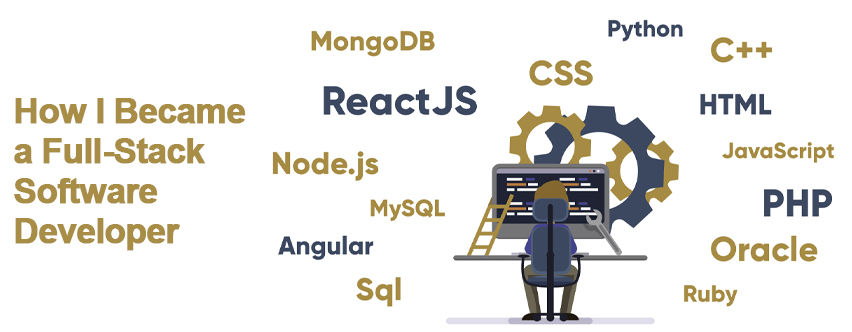Becoming a full-stack software developer is a journey that involves mastering both front-end and back-end technologies. It’s a rewarding career choice, offering versatility and ample job opportunities in the ever-evolving tech industry. If you’re wondering how to embark on this exciting path, you’ve come to the right place. In this blog, I’ll share my personal journey of becoming a full-stack software developer, provide valuable insights, and answer some frequently asked questions to help you on your way.
Table of Contents
The Full-Stack Developer Journey
My Story
I began my journey as a software enthusiast with a passion for problem-solving and a love for technology. Here’s a condensed version of my path to becoming a full-stack developer:
1. Learning the Basics
I started with the fundamentals of programming, mastering languages like HTML, CSS, and JavaScript. These languages form the foundation of both front-end and back-end development.
2. Front-End Development
Next, I delved into front-end development, which focuses on creating the user interface and user experience. I honed my skills in web design, responsive design, and various front-end frameworks like React, Angular, and Vue.js.
3. Back-End Development
To complete my full-stack journey, I needed to tackle the back-end. Learning server-side programming languages such as Python, Ruby, or Node.js was essential. I also became proficient in working with databases, using technologies like MySQL, PostgreSQL, or MongoDB.
4. Building Projects
The best way to learn is by doing. I started building small projects and gradually progressed to more complex applications. This hands-on experience taught me how to apply what I had learned in real-world scenarios.
5. Staying Updated
The tech industry is ever-changing. To stay relevant, I made a habit of continuous learning. I followed blogs, attended workshops, and joined developer communities to stay up-to-date with the latest trends and technologies.
Comparison Table: Front-End vs. Back-End Development
Let’s take a closer look at the key differences between front-end and back-end development:
| Aspect | Front-End Development | Back-End Development |
|---|---|---|
| Focus | User interface and user experience | Server-side functionality |
| Languages & Frameworks | HTML, CSS, JavaScript | Python, Ruby, Node.js, Java, etc. |
| Interaction | Direct interaction with users | Indirect interaction with servers |
| Responsiveness | Ensuring a seamless user experience | Managing data and server processes |
| Tools & Technologies | Front-end libraries and frameworks | Server technologies, databases |
| Typical Projects | Web and mobile app interfaces | Server applications, APIs |
Stats: The Full-Stack Developer Job Market
The demand for full-stack developers continues to grow, with businesses seeking professionals who can work on all aspects of web and software development. Here are some statistics that highlight the job market’s attractiveness:
- According to the U.S. Bureau of Labor Statistics, the employment of web developers is projected to grow by 13% from 2020 to 2030, faster than the average for all occupations.
- Full-stack developers typically command higher salaries due to their versatility. The average salary for full-stack developers in the United States ranges from $80,000 to $150,000 per year, depending on experience and location.
- Tech giants like Google, Facebook, Amazon, and Microsoft are always on the lookout for full-stack developers to work on their diverse projects.
FAQ: Common Questions About Becoming a Full-Stack Developer
1. How long does it take to become a full-stack developer?
The time it takes to become a full-stack developer varies depending on your prior experience and dedication. On average, it might take anywhere from 6 months to 2 years of consistent learning and practice.
2. Do I need a formal degree to become a full-stack developer?
While a formal degree in computer science can be helpful, it’s not mandatory. Many full-stack developers are self-taught or have completed coding bootcamps and online courses.
3. What are some recommended resources for learning full-stack development?
- Online courses and platforms like Udemy, Coursera, and edX offer comprehensive full-stack development courses.
- Coding bootcamps like General Assembly, Le Wagon, and Flatiron School provide intensive, hands-on training.
- Books and documentation from reputable sources like Mozilla Developer Network (MDN) and W3Schools can be valuable references.
4. How can I build a portfolio to showcase my skills?
Start by creating personal projects or contributing to open-source projects. Display your work on platforms like GitHub and build a personal website to showcase your projects, skills, and resume.
5. What soft skills are important for a full-stack developer?
In addition to technical skills, soft skills such as problem-solving, communication, teamwork, and adaptability are crucial. Full-stack developers often collaborate with diverse teams and need to find solutions to complex problems.
Conclusion
Becoming a full-stack software developer is an achievable goal with the right mindset, dedication, and a strategic learning path. Whether you’re starting from scratch or transitioning from another field, the journey can be both challenging and rewarding. By mastering front-end and back-end technologies, continuously learning, and building a strong portfolio, you can embark on a successful career in full-stack development. Stay curious, stay persistent, and embrace the ever-evolving tech landscape as you pursue your dream of becoming a full-stack software developer.


Leave a Reply